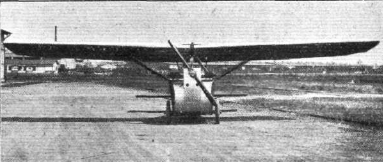Albatros L.66 on:
[Wikipedia]
[Google]
[Amazon]
The Albatros L.66 was a simple, low powered, two seat sports and training parasol wing monoplane, built in Germany in the mid-1920s.
 The first L.66 was flying in mid-1924 with the Haacke engine. In all ten were built.
The first L.66 was flying in mid-1924 with the Haacke engine. In all ten were built.

Design and development
The L.66 was intended to be a low cost, easy maintenance two-seater. Thus a low power engine was required and the prototype was fitted with a Haacke HFM-2 flat twin, though other engines could be used. It was a cantilever parasol monoplane with an aerodynamically thickairfoil
An airfoil (American English) or aerofoil (British English) is the cross-sectional shape of an object whose motion through a gas is capable of generating significant lift, such as a wing, a sail, or the blades of propeller, rotor, or turbine.
...
section wing, which had a simple, rectangular plan and significant dihedral. The wing was a wooden structure with two spars
The United States Coast Guard (USCG) Women's Reserve, also known as the SPARS (SPARS was the acronym for "Semper Paratus—Always Ready"), was the women's branch of the United States Coast Guard Reserve. It was established by the United States ...
, the aileron
An aileron (French for "little wing" or "fin") is a hinged flight control surface usually forming part of the trailing edge of each wing of a fixed-wing aircraft. Ailerons are used in pairs to control the aircraft in roll (or movement around ...
s mounted directly to a rounded groove in the rear spar. It was linked to the upper fuselage by a rather complicated set of struts.
Traditionally, Albatros had constructed fuselages with wood frames, but the L.66 marked a departure, with a welded steel tube longeron
In engineering, a longeron and stringer is the load-bearing component of a framework.
The term is commonly used in connection with aircraft fuselages and automobile chassis. Longerons are used in conjunction with stringers to form structural ...
and strut framework covered with fabric. The sides were flat and almost airfoil-shaped, with a blunt, rounded nose and taper aft. The nose-mounted engine, driving a two-blade propeller
A propeller (colloquially often called a screw if on a ship or an airscrew if on an aircraft) is a device with a rotating hub and radiating blades that are set at a pitch to form a helical spiral which, when rotated, exerts linear thrust upon ...
, was raised above the fuselage with a fairing behind it, enclosing the oil tank and with the instrument panel attached to its rear. The fuel tank was in the wing centre section, feeding the engine by gravity. Further aft, pilot and passenger sat side by side in the wide fuselage; tandem controls could be fitted if required. The empennage was simple in shape and action as there were no fixed surfaces, only an all-moving rudder and elevator. Both control surfaces were balanced. The conventional undercarriage
Conventional landing gear, or tailwheel-type landing gear, is an aircraft undercarriage consisting of two main wheels forward of the center of gravity and a small wheel or skid to support the tail.Crane, Dale: ''Dictionary of Aeronautical Term ...
was also very simple, with the mainwheels attached to a single axle which passed through the fuselage, sitting the L.66 close to the ground. The tailskid was linked to the rudder for steering on the ground
Operational history
 The first L.66 was flying in mid-1924 with the Haacke engine. In all ten were built.
The first L.66 was flying in mid-1924 with the Haacke engine. In all ten were built.
Variants
;L.66: Haacke engine. ;L.66a: Slightly larger and heavier, with Stahlwerk Mark St.M3 or Anzani engine. ;L.66c: ;L.67:Lighter version, Bristol Cherub or Anzani engine. Two built.Specifications (Haacke engine)

References
{{Albatros aircraft 1920s German sport aircraft Parasol-wing aircraft L 066 Single-engined tractor aircraft Aircraft first flown in 1924